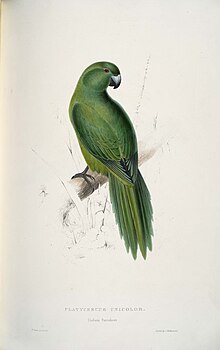Antipodes parakeet
| Antipodes parakeet | |
|---|---|

| |
| A parakeet at Ringdove Bay on Antipodes Island. | |
| Scientific classification | |
| Domain: | Eukaryota |
| Kingdom: | Animalia |
| Phylum: | Chordata |
| Class: | Aves |
| Order: | Psittaciformes |
| Family: | Psittaculidae |
| Genus: | Cyanoramphus |
| Species: | C. unicolor
|
| Binomial name | |
| Cyanoramphus unicolor (Lear, 1831)
| |

| |
Native range
| |
The Antipodes parakeet or Antipodes Island parakeet (Cyanoramphus unicolor) is a parrot in the family Psittaculidae that is endemic to the Antipodes Islands of New Zealand. It is one of two parrot species found on the islands, and one of only five ground-dwelling parrots in the world. They are long-living birds that may live up to 10 years of age, but the introduction of mice that compete with them for food was a threat to their survival on the Antipodes Islands until the mice were successfully eradicated from the Islands in 2016 (confirmed 2018).[3] Unusually for parrots, they sometimes prey upon other birds, a trait shared by another New Zealand parrot, the kea.
Taxonomy
[edit]The Antipodes parakeet was depicted in 1831 by English artist Edward Lear in his Illustrations of the Family of Psittacidae, or Parrots. Lear used the common name "uniform parakeet" and coined the binomial name Platycercus unicolor.[4] The species is now placed in the genus Cyanoramphus that was introduced in 1854 by French ornithologist Charles Lucien Bonaparte.[5][6]
Its closest relative is Reischek's parakeet, which also lives on the Antipodes Islands. Other relatives include the Norfolk parakeet, Society parakeet, and Chatham Islands parakeet.
Description
[edit]It is the largest species in the genus Cyanoramphus at 30 cm (12 in) long.[7] and makes a penetrating kok-kok-kok-kok noise.

Distribution and habitat
[edit]The Antipodes parakeet is endemic to the Antipodes Islands of New Zealand. They are common on the main Antipodes Island, but are less common on smaller islands in the group such as Bollons Island. They live in very small numbers on Leeward Island, where they only live in a 0.1 km2 (0.039 sq mi) region of the island. The Antipodes parakeet lives on the 0.1 km2 (0.039 sq mi) Archway Island, as well.
Behaviour and ecology
[edit]These parakeets eat leaves, buds, grass, and tussock stalks, as well as sometimes feeding on seeds and flowers, and sometimes scavenge dead seabirds. The Antipodes parakeet also preys on grey-backed storm petrels, entering burrows to kill incubating adults, even digging at the entrance if it is too small.[8]
Antipodes parakeets spend much of their time on the ground and in very small groups, in pairs, or alone.
They are quite inquisitive, territorial, probing, and mischievous.[9]
Their nest is in a tunnel 2 m beneath fibrous peat away from the wind.[10]
Status
[edit]Their population is stable, but their conservation status is vulnerable. The population is 2,000-3,000.[1] Originally entirely restricted to the islands that bear their name, a small captive population, founded with less than 20 individuals, now inhabits the mainland.
See also
[edit]References
[edit]- ^ a b BirdLife International. (2022). "Cyanoramphus unicolor". IUCN Red List of Threatened Species. 2022: e.T22685162A213655486. doi:10.2305/IUCN.UK.2022-2.RLTS.T22685162A213655486.en. Retrieved 5 September 2024.
- ^ "Appendices | CITES". cites.org. Retrieved 2022-01-14.
- ^ S. Horn; T. Greene; G. Elliott. "Eradication of mice from Antipodes Island, New Zealand" (PDF). NZ Department of Conservation.
- ^ Lear, Edward (1831). Illustrations of the Family of Psittacidae, or Parrots. London: Published by the author. Plate 25.
- ^ Bonaparte, Charles Lucien (1854). "Tableau des perroquets". Revue et Magasin de Zoologie Pure et Appliquée. 2nd series. 6: 145–158 [153].
- ^ Gill, Frank; Donsker, David; Rasmussen, Pamela, eds. (2020). "Parrots, cockatoos". IOC World Bird List Version 10.1. International Ornithologists' Union. Retrieved 24 February 2020.
- ^ Forshaw, Joseph M. (2006). Parrots of the World; an Identification Guide. Illustrated by Frank Knight. Princeton University Press. Plate 59. ISBN 0-691-09251-6.
- ^ Greene, Terry C. (1999). "Aspects of the ecology of Antipodes Parakeet (Cyanoramphus unicolor) and Reischek's Parakeet (C. novaezelandiae hochstetteri) on Antipodes Island, October - November 1995" (PDF). Notornis. 46: 301–310.
- ^ "Captive Management Plan Antipodes Island Parakeet" (PDF). Department of Conservation. 1995.
- ^ "New Zealand ecology - Antipodes Island parakeet (Cyanoramphus unicolor)". TerraNature.
External links
[edit]- World Parrot Trust Parrot Encyclopedia - Species Profile
- BirdLife Species Factsheet.
- ARKive - images and movies of the Antipodes Parakeet (Cyanoramphus unicolor)
- Antipodes Parakeet TerraNature | New Zealand ecology

